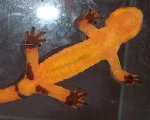- Joined
- May 8, 2013
- Messages
- 2,685
- Reaction score
- 131
- Points
- 48
- Location
- Chesterfield, England
- Country
- England
Thanks Seth for the feeding advice! I hope I haven't caused any damage!…. And slow foot that is also good direction. The tanks as I bought them came without lids but I may be able to throw together a screen top or something. Also, I've got a toddler at home who is figuring out how to destroy things so it probably ain't a bad idea! Thanks guys! I'll keep posting pics of the progress.
Keeping toddlers out is as important as keeping the newts in, don't forget how poisonous salamanders are! A Taricha/toddler situation could easily be fatal to either party.











